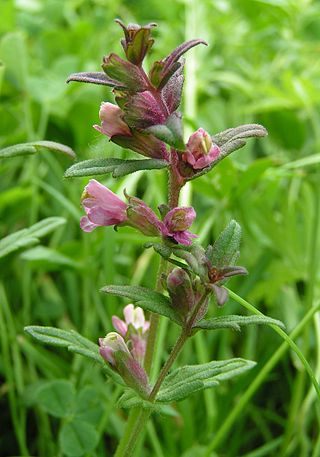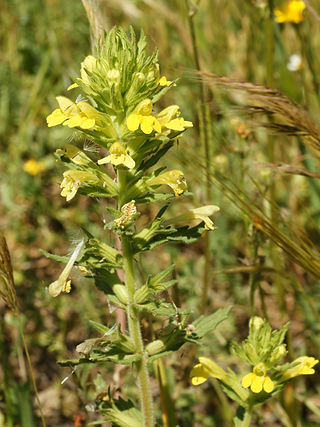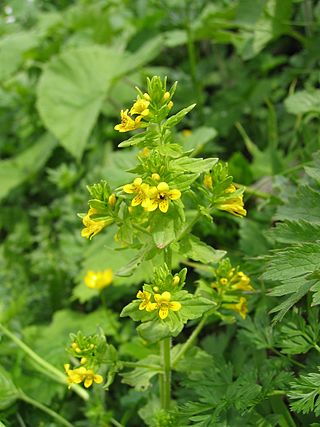
Lathraea (toothwort) is a small genus of five to seven species of flowering plants, native to temperate Europe and Asia. They are parasitic plants on the roots of other plants, and are completely lacking chlorophyll. They are classified in the family Orobanchaceae.

Odontites is a genus of flowering plants in the family Orobanchaceae.

Paulowniaceae are a family of flowering plants within the Lamiales. They are a monophyletic and monogeneric family of trees with currently 7 confirmed species. They were formerly placed within Scrophulariaceae sensu lato, or as a segregate of the Bignoniaceae.

Orobanchaceae, the broomrapes, is a family of mostly parasitic plants of the order Lamiales, with about 90 genera and more than 2000 species. Many of these genera were formerly included in the family Scrophulariaceae sensu lato. With its new circumscription, Orobanchaceae forms a distinct, monophyletic family. From a phylogenetic perspective, it is defined as the largest crown clade containing Orobanche major and relatives, but neither Paulownia tomentosa nor Phryma leptostachya nor Mazus japonicus.

Euphrasia, or eyebright, is a genus of about 450 species of herbaceous flowering plants in the family Orobanchaceae, with a cosmopolitan distribution. They are hemiparasitic on grasses and other plants. The common name refers to the plant's use in treating eye infections.

Melampyrum is a genus of about 20 species of herbaceous flowering plants in the family Orobanchaceae known commonly as cow wheat. They are native to temperate regions of the Northern Hemisphere. They are hemiparasites on other plants, obtaining water and nutrients from host plants, though they are able to survive on their own without parasitising other plants.

Crotoneae is a tribe of the subfamily Crotonoideae, under the family Euphorbiaceae. It comprises five genera.

Rhinanthus is a genus of annual hemiparasitic herbaceous plants in the family Orobanchaceae, formerly classified in the family Scrophulariaceae. Its species are commonly known as rattles. The genus consists of about 30 to 40 species found in Europe, northern Asia, and North America, with the greatest species diversity in Europe.

Haloragaceae is a eudicot flowering plant family in the order Saxifragales, based on the phylogenetic APG system. In the Cronquist system, it was included in the order Haloragales.

Banksia subg. Spathulatae is a valid botanic name for a subgenus of Banksia. It was published in 2007 by Austin Mast and Kevin Thiele, and defined as containing all those Banksia species having spathulate (spoon-shaped) cotyledons. The name was published to accommodate forthcoming changes to the taxonomic arrangement of Banksia, based on the DNA sequence analyses of Austin Mast and others, which suggested a phylogeny for Banksia very greatly different from the accepted taxonomic arrangement. They found Banksia to be paraphyletic with respect to Dryandra, and that these two genera were best split into two clades, one with beaked follicles and non-spathulate cotyledons, the other with unbeaked follicles and spathulate cotyledons. Initially this clade was informally named "/Cryptostomata", in reference to the stomates, which are sunken with constricted entrances. Accordingly, in 2007 Mast and Thiele initiated a rearrangement by transferring Dryandra to Banksia, and publishing B. subg. Spathulatae for the species having spathulate cotyledons. The type species of Spathulatae was given as B. integrifolia, but no further details have been given. Mast and Thiele have foreshadowed publishing a full arrangement once DNA sampling of Dryandra is complete.

Bartsia is a genus of flowering plants in the family Orobanchaceae.

Bellardia trixago is a species of flowering plant in the family Orobanchaceae. The only member of the monotypic genus Bellardia, it is known as trixago bartsia or Mediterranean lineseed. This plant is native to the Mediterranean Basin, but it is known in other places with similar climates, such as California and parts of Chile, where it is an introduced species and noxious weed.

Parentucellia is a small genus of flowering plants in the family Orobanchaceae containing about four species. They are known generally as glandweeds. The genus was named for Pope Nicholas V, whose surname was Parentucelli.

Rhynchocorys is a small genus of flowering plants belonging to the family Orobanchaceae, formerly classified in the family Scrophulariaceae. It is native to Europe, Morocco and Algeria.

Tozzia is a monotypic genus of flowering plants within the broomrape family Orobanchaceae. It contains a unique species, Tozzia alpina.

Hedbergia is a monotypic genus of flowering plants, initially classified in Scrophulariaceae, and now within the broomrape family Orobanchaceae. It contains a unique species, Hedbergia abyssinica. It is an afromontane genus, widespread in grasslands and scrubs of the mountains of tropical Africa, and known from Ethiopia, Zaire, Uganda, Kenya, Tanzania, Malawi, Nigeria, and Cameroons.

Hedbergia decurva, formerly Bartsia decurva, is a species of flowering plants in the family Orobanchaceae.
Hedbergia longiflora, formerly Bartsia longiflora, is a species of flowering plants in the family Orobanchaceae.
Bartsiella is a monotypic genus of flowering plants, initially classified in Scrophulariaceae, and now within the broomrape family Orobanchaceae. It contains a unique species, Bartsiella rameauana.
Barbara Ann Whitlock is a botanist, who earned a Ph.D. from Harvard University, with her dissertation Systematics and evolution of chocolate and its relatives c. 2000, an interest which continues.

















